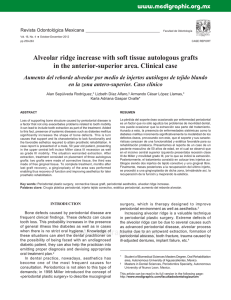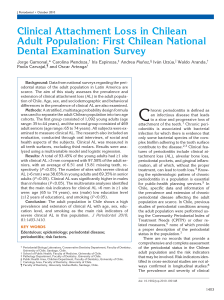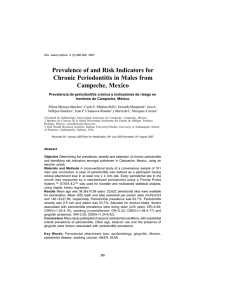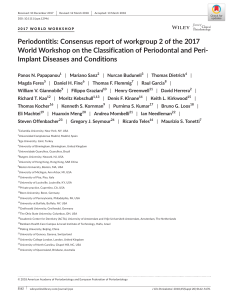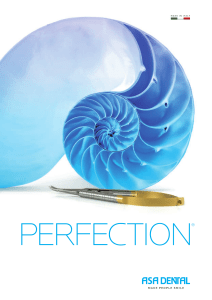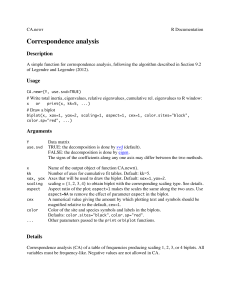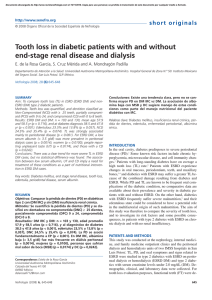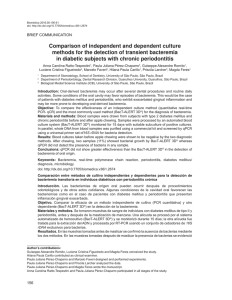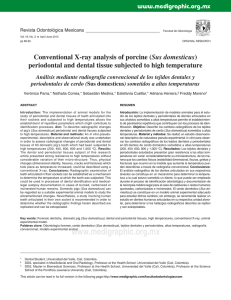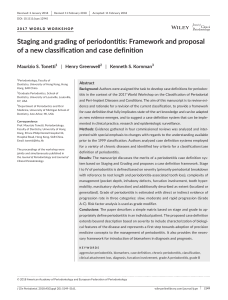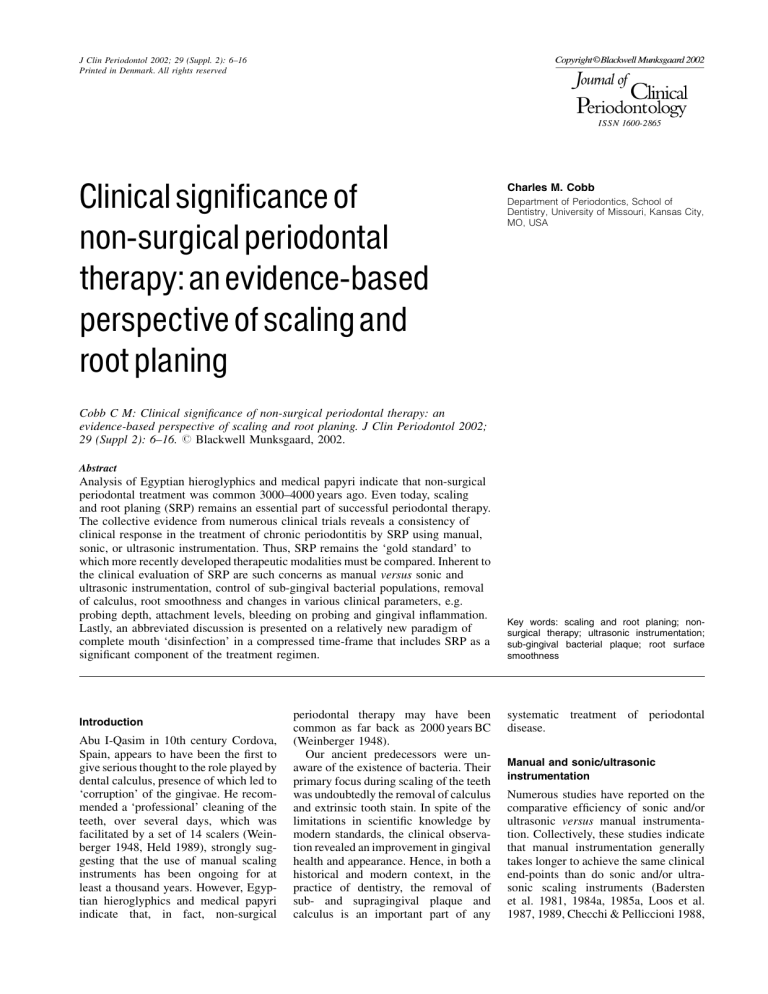
J Clin Periodontol 2002; 29 (Suppl. 2): 6–16 Printed in Denmark. All rights reserved Clinical significance of non-surgical periodontal therapy: an evidence-based perspective of scaling and root planing Charles M. Cobb Department of Periodontics, School of Dentistry, University of Missouri, Kansas City, MO, USA Cobb C M: Clinical significance of non-surgical periodontal therapy: an evidence-based perspective of scaling and root planing. J Clin Periodontol 2002; 29 (Suppl 2): 6–16. # Blackwell Munksgaard, 2002. Abstract Analysis of Egyptian hieroglyphics and medical papyri indicate that non-surgical periodontal treatment was common 3000–4000 years ago. Even today, scaling and root planing (SRP) remains an essential part of successful periodontal therapy. The collective evidence from numerous clinical trials reveals a consistency of clinical response in the treatment of chronic periodontitis by SRP using manual, sonic, or ultrasonic instrumentation. Thus, SRP remains the ‘gold standard’ to which more recently developed therapeutic modalities must be compared. Inherent to the clinical evaluation of SRP are such concerns as manual versus sonic and ultrasonic instrumentation, control of sub-gingival bacterial populations, removal of calculus, root smoothness and changes in various clinical parameters, e.g. probing depth, attachment levels, bleeding on probing and gingival inflammation. Lastly, an abbreviated discussion is presented on a relatively new paradigm of complete mouth ‘disinfection’ in a compressed time-frame that includes SRP as a significant component of the treatment regimen. Introduction Abu I-Qasim in 10th century Cordova, Spain, appears to have been the first to give serious thought to the role played by dental calculus, presence of which led to ‘corruption’ of the gingivae. He recommended a ‘professional’ cleaning of the teeth, over several days, which was facilitated by a set of 14 scalers (Weinberger 1948, Held 1989), strongly suggesting that the use of manual scaling instruments has been ongoing for at least a thousand years. However, Egyptian hieroglyphics and medical papyri indicate that, in fact, non-surgical periodontal therapy may have been common as far back as 2000 years BC (Weinberger 1948). Our ancient predecessors were unaware of the existence of bacteria. Their primary focus during scaling of the teeth was undoubtedly the removal of calculus and extrinsic tooth stain. In spite of the limitations in scientific knowledge by modern standards, the clinical observation revealed an improvement in gingival health and appearance. Hence, in both a historical and modern context, in the practice of dentistry, the removal of sub- and supragingival plaque and calculus is an important part of any Key words: scaling and root planing; nonsurgical therapy; ultrasonic instrumentation; sub-gingival bacterial plaque; root surface smoothness systematic treatment of periodontal disease. Manual and sonic/ultrasonic instrumentation Numerous studies have reported on the comparative efficiency of sonic and/or ultrasonic versus manual instrumentation. Collectively, these studies indicate that manual instrumentation generally takes longer to achieve the same clinical end-points than do sonic and/or ultrasonic scaling instruments (Badersten et al. 1981, 1984a, 1985a, Loos et al. 1987, 1989, Checchi & Pelliccioni 1988, Perspective on scaling and root planing Kawanami et al. 1988, Laurell & Pettersson 1988, Laurell 1990, Dragoo 1992, Copulos et al. 1993, Grant et al. 1993, Boretti et al. 1995, Drisko 1995, Kocher et al. 1997, Yukna et al. 1997). In fact, several studies have reported that use of sonic and/or ultrasonic instruments can result in a 20–50% savings in time compared with manual instrumentation when used for periodontal debridement procedures (Checchi & Pelliccioni 1988, Dragoo 1992, Copulos et al. 1993, Drisko 1995). The time required to achieve clinical endpoints is only one of several factors in the equation to determine instrument efficiency. Obviously, achievement of desired clinical end-points is severely impacted by restricted access. Waerhaug (1978a, 1978b) and later, Stambaugh et al. (1981) noted that the chances of removing all sub-gingival plaque from all tooth surfaces was fairly good if the probing depth was 3.0 mm. At probing depths of 3–5 mm, the chance of failure becomes greater than the chance of success. At probing depths 5.0 mm, the chance of failure becomes significantly dominant. In fact, Stambaugh et al. (1981) noted that removal of all subgingival plaque and calculus was unlikely to occur when mean probing depths were 3.73 mm. In this regard, it is interesting to note that both Dragoo (1992) and Clifford et al. (1999) have evaluated traditional and ‘microultrasonic’ scaling tips for their ability to reach the most apical extension of periodontal pockets and reported conflicting results. Dragoo (1992) reported that only rarely did any of the instruments approach the most apical depth of the pocket. On the other hand, Clifford et al. (1999) reported that both types of scaling tips were able to reach and debride the apical plaque border in pockets in 4–6 mm and 7 mm pockets. Notwithstanding apparent limitations in sub-gingival mechanical therapy, regardless of instrument type, the periodontal literature contains numerous reports supporting successful long-term maintenance following either surgical or non-surgical therapy (Hill et al. 1981, Pihlstrom et al. 1983, 1984, Lindhe & Nyman 1984, Lindhe et al. 1984, Ramfjord et al. 1987, Kaldahl et al. 1996a). This paradox can be explained, in part, by the concept of ‘critical mass’ (WWP 1989). As applied to non-surgical periodontal therapy, the concept of critical mass is best understood by assuming that a major goal of periodontal therapy is to reduce the quantity (mass) of bacterial plaque to a level (critical) that results in an equilibrium between the residual microbes and the host response, i.e. no clinical disease. Given the physical limitations, both anatomical and instrumentational, of sub-gingival scaling and/or root planing, one may argue that it is whimsical to assume that clinicians can remove all sub-gingival plaque and calculus. Control of sub-gingival bacterial plaque The efficacy of periodontal therapy is directly related to the ability of treatment to lower levels and/or prevalence of one or more pathogenic bacterial species. Treatment of chronic periodontitis using manual instrumentation for sub-gingival scaling is likely to result in a modest, albeit transient, shift in the composition of the microbial flora (Listgarten et al. 1978, Slots et al. 1979, Mousques et al. 1980, Singletary et al. 1982, Greenwell & Bissada 1984, Magnusson et al. 1984, Hinrichs et al. 1985, Lavanchy et al. 1987, van Winkelhoff et al. 1988, Southard et al. 1989, Chaves et al. 2000, Stelzel & Florès-de-Jacoby 2000). In general, sub-gingival scaling effectively decreases the population of Gramnegative microbes while concomitantly allowing for an increase in the populations of Gram-positive rods and cocci. This shift towards a more dominate population of Gram-positive microbes is usually associated with gingival health (Listgarten et al. 1978, Slots et al. 1979, Mousques et al. 1980, Singletary et al. 1982, Greenwell & Bissada 1984, Magnusson et al. 1984, Hinrichs et al. 1985, Harper & Robinson 1987, Lavanchy et al. 1987, van Winkelhoff et al. 1988, Southard et al. 1989, Sbordone et al. 1990, Haffajee et al. 1997a, Stelzel & Florès-de-Jacoby 2000). Recently, Haffajee et al. (1997a, b) and Cugini et al. (2000) reported that scaling and root planing resulted in significant decreases in DNA probe counts of a specific subset of sub-gingival microbes consisting of Porphyromonas gingivalis, Bacteroides forsythus and Treponema denticola. Concomitant with decreases in this subset of bacteria were significant increases in Actinomyces sp., Capnocytophaga sp., Fusobacterium nucleatum subsp. polymorphum, Streptococcus mitis, and Veillonella parvula. Similar results showing decreased levels of P. gingivalis and T. denticola have 7 been reported by Ali et al. (1992), Simonson et al. (1992), Shiloah & Patters (1994), and Lowenguth et al. (1995). Although spirochetes, motile microbes, and Bacteroides sp. are routinely reduced in numbers after scaling and root planing, other species appear more resistant, such as Actinobacillus actinomycetemcomitans and P. gingivalis (Slots & Rosling 1983, Pihlstrom et al. 1984, Christersson et al. 1985, Harper & Robinson 1987, van Winkelhoff et al. 1988, Southard et al. 1989, Renvert et al. 1990a, Sbordone et al. 1990, Gunsolley et al. 1994, Mombelli et al. 1994b, Shiloah & Patters 1994, von Troil-Lindén et al. 1996, Haffajee et al. 1997a). The persistence of specific sub-gingival species including A. actinomycetemcomitans, P. gingivalis and T. denticola has been associated with poor response to treatment by scaling and root planing (Haffajee & Socransky 1994, Haffajee et al. 1994, 1997a, Chaves et al. 2000). Indeed, Haffajee et al. (1997a) reported that scaling and root planing was a useful treatment for 68% of the subjects in their study, resulting in no loss or a modest gain in mean attachment levels. Thus, 32% of the subjects exhibited little benefit from non-surgical therapy and continued to have elevated levels of putative pathogens and progressive loss of attachment. The persistence of P. gingivalis, Prevotella intermedia/nigrescens (Sato et al. 1993, Mombelli et al. 2000), A. actinomycetemcomitans (Mombelli et al. 2000), Campylobacter recta and F. nucleatum (Sato et al. 1993) is reported to have a highly significant relationship with bleeding on probing. In addition, Mombelli et al. (2000) found a direct correlation between the increasing number of post-treatment residual pockets of >4 mm and the number of P. gingivalis-positive sites. The inability of sub-gingival instrumentation to eradicate A. actinomycetemcomitans and P. gingivalis has been attributed to their ability to invade the subjacent periodontal tissues (Slots & Rosling 1983, Christersson et al. 1985, Shiloah & Patters 1994), existing high pretreatment levels and deep initial probing depths (Mombelli et al. 1994a, 1994b). In addition, several studies have demonstrated the presence of bacteria in root cementum and radicular dentin of periodontally diseased teeth. Such bacterial invasion of root structure may represent a reservoir of periodontopathic bacteria for recolonization and 8 Cobb re-infection (Daly et al. 1982, Adriaens et al. 1988, Giuliana et al. 1997). Furthermore, sub-gingival therapy does little to address other oral sites that may act as a source for re-emerging periodontal pathogens, e.g. posterior tongue and peritonsillar areas (von Troil-Lindén et al. 1996). It is recognized that shifts to a sub-gingival microbial flora representative of health appear to be transient. Thus, to sustain the positive effects of periodontal treatment, scaling and root planing must be performed periodically during the maintenance phase of therapy (Westfelt et al. 1983, Lindhe & Nyman 1984, Harper & Robinson 1987, van Winkelhoff et al. 1988, Renvert et al. 1990a, Shiloah & Patters 1996). Studies regarding the effect of ultrasonic instrumentation on the sub-gingival microbial flora and microbial toxins are relatively few but consistent in their findings. When this small number of investigations is evaluated as a collected body of literature, one common agreement appears to exist, that is manual, sonic and ultrasonic scalers cannot effect the complete removal of sub-gingival bacterial plaque and calculus, and they all achieve similar clinical and microbiological results (Lie & Meyer 1977, Thornton & Garnick 1982, Hunter et al. 1984, Eaton et al. 1985, Lie & Leknes 1985, Gellin et al. 1986, Breininger et al. 1987, Kawanami et al. 1988, Coldiron et al. 1990, Baehni et al. 1992, Dragoo 1992, Jotikasthira et al. 1992, Bollen & Quirynen 1996, Checchi et al. 1997). Removal of sub-gingival calculus The concept of removing all sub-gingival calculus and contaminated cementum has been shown to be unrealistic and quite likely unnecessary (Borghetti et al. 1987, Breininger et al. 1987, Kepic et al. 1990, Robertson 1990, Sherman et al. 1990a, 1990b, Eschler & Rapley 1991, Fukazawa & Nishimura 1994). Further, it appears that a clinically acceptable level of gingival wound healing occurs, despite the presence of microscopic aggregates of residual root calculus (Nyman et al. 1986, Blomlöf et al. 1987, Buchanan & Robertson 1987). Even though complete removal of sub-gingival calculus is not likely to occur, and removal of cementum is unnecessary, it appears that a considerable root detoxification and gingival healing is accomplished using multiple light strokes with a sonic or ultrasonic scaler (Badersten et al. 1981, 1984a, 1984b, Nyman et al. 1986, Checchi & Pelliccioni 1988, Cheetham et al. 1988, Smart et al. 1990, Chiew et al. 1991). Numerous studies have demonstrated that sonic or ultrasonic instrumentation, when compared with manual instrumentation, achieves equal or superior treatment outcomes (Lie & Meyer 1977, Torfason et al. 1979, Thornton & Garnick 1982, Badersten et al. 1984a, 1984b, Lie & Leknes 1985, Loos et al. 1987, Laurell & Pettersson 1988, Laurell 1990, Copulos et al. 1993). Root surface smoothness It has long been assumed by clinicians that a smooth root surface is also a clean surface. Yet it remains to be determined that a smooth root surface is a desirable end-point of non-surgical periodontal therapy. There are relatively few reports dealing with the impact of root surface roughness on wound healing or, in the reverse, the biocompatibility of a smooth root surface (Rosenberg & Ash 1974, Khatiblou & Ghodssi 1983, Lindhe et al. 1984, Leknes et al. 1996, Oberholzer & Rateitschak 1996). Early on, Rosenberg & Ash (1974) concluded that root surface roughness resulting from instrumentation by manual curettes and ultrasonic scalers had no significant effect on plaque retention or gingival inflammation. These observations were later supported by Khatiblou & Ghodssi (1983) and Oberholzer & Rateitschak (1996), who reported that periodontal healing, reductions in probing depth, and attachment gains, were independent of root surface texture. However, such observations are in contrast to those of Waerhaug (1956), who noted that intentional roughening of sub-gingival enamel in dogs resulted in an increased deposition of bacterial plaque and calculus. Several other studies have noted the direct relationship between surface roughness and the rate of supragingival bacterial colonization (Keenan et al. 1980, Budtz-Jorgensen & Kaaber 1986, Quirynen & Listgarten 1990, Leknes et al. 1996). Further, both Quirynen & Bollen (1995) and Leknes et al. (1996) have noted that rough supragingival surfaces accumulate and retain more bacterial plaque. In addition, Quirynen & Bollen (1995) report that gingivitis and periodontitis is more frequently associated with teeth exhibiting a rough surface. Not so surprising, then, are the observations by Lindhe et al. (1984), who noted that smooth root surfaces were compatible with normal healing of the dentogingival complex. Schlageter et al. (1996), using an in vitro study design, reported an instrument hierarchy of smooth to rough root surfaces using an average roughness value (Ra) to be 15 mm rotating diamond (1.64 0.81), Gracey curette (1.90 0.84), Perioplaner curette (2.10 1.03), piezo-electric scaler (2.48 0.90), 75 mm rotating diamond (2.60 1.06) and the sonic scaler (2.71 1.12). The significance of the study by Schlageter et al. (1996) lies in the Ra values, none of which appear to achieve a surface smoothness threshold of Ra ¼ 0.2 mm, below which no impact on bacterial adhesion and/or colonization should be expected. However, surfaces with a roughness exceeding the 0.2 mm threshold should be expected to facilitate greater amounts of bacterial plaque accumulation (Quirynen et al. 1993, Bollen et al. 1996a). In fact, a study using titanium implant abutments indicated that an Ra value of 0.8 mm resulted in a dramatic increase in subgingival plaque (25) when compared with surfaces with an Ra value of 0.2 mm (Quirynen et al. 1996). Thus, a comparison of the Ra values reported by Schlageter et al. (1996) with the threshold value of 0.2 mm would lead one to assume that achieving root surface smoothness with the instrumentation available at present is simply not possible. Given that the smoothest root surface in the study by Schlageter et al. (1996) had an Ra value roughly 8 greater than the threshold value of 0.2 mm, it would appear that for the foreseeable future, sub-gingival microbes will continue to have a friendly surface for colonization. Changes in probing depth and attachment level Reduction in probing depth following mechanical instrumentation results from a combination of gain in clinical attachment and gingival recession (Hughes & Caffesse 1978, Proye et al. 1982). The magnitude of probing depth reduction and gains in attachment levels are related to the initial measurement, a phenomena supported by the collective data reported in various clinical studies over several decades (Cobb 1996) (Table 1). For example, the mean reduction in probing depths with an initial depth of 1–3 mm has been calculated to be 0.03 mm with a mean net loss in attachment level of 9 Perspective on scaling and root planing Table 1. Summary from selected studies reporting the mean decrease in probing depth and changes in clinical attachment levels following nonsurgical treatment of moderate to severe periodontitis using manual scalers/curettes Mean decrease in probing depth (mm), month: Reference Torfason et al. (1979) Badersten et al. (1981) Pihlstrom et al. (1981) Caton et al. (1982) Cercek et al. (1983) Badersten et al. (1984a) Becker et al. (1988) Claffey et al. (1988) Kaldahl et al. (1988) Laurell & Pettersson (1988) Copulos et al. (1993) Drisko et al. (1995) Haffajee et al. (1997a) Noyan et al. (1997) Soskolne et al. (1997) Jeffcoat et al. (1998) Garrett et al. (1999) Kinane & Radvar (1999) Preshaw et al. (1999) Cugini et al. (2000)ô Machtei et al. (2000) Stelzel et al. (2000) IPD (mm) 1 5.00 4.30 4–6.0 6.0 4–7.0 3.5–5 5.70 4–6.0 7.0 4–6.5 5–6.0 7.0 4.0 5.07 5.34 4–6.0 5.0 6.01 5–8.0 5.30 7.55 5.0 5.73 > 6.0 1.10y 0.0z 6.02 3 1.30 0.56 0.73 9 1.25 0.94 1.66 1.39 1.00 0.0z 26%§ 6 1.20 1.23 2.18 66% 0.70 0.75 0.4z 0.45 1.40 Change in attachment level (mm), month: 12 1 1.10 0.10z 1.60 0.86 1.54 1.30 3 6 9 0.25 0.56 1.40 0.70 0.10 0.10z 0.10 0.20 12 0.10 0.20 0.49 1.54 0.40 0.96 1.66 0.50 2.01 0.50 0.2z 0.25 0.25 0.63 0.70 0.45 0.95 0.58 0.50 1.05 0.5z 0.50 0.50 0.50 1.20 0.20 0.59 0.73 0.72 1.00 1.70 0.71 0.65 0.90 1.65 1.0z 1.20 1.70 0.63 1.56 1.56 0.19 0.90 0.44 1.20 IPD, initial probing depth (indicates mean IPD). yMean for all pockets regardless of location. zCalculated from published data tables and does not include decreases in probing depth or increases in attachment level due to oral hygiene. §Percentage reduction in the mean number of pockets of 4.0 at 1 and 4 months post-treatment. ôTwelve-month results calculated from published data tables and represents data from subset of patients in the study by Haffajee et al. (1997a). 0.34 mm. For those pockets initially measuring 4–6 mm, the mean reduction in probing depth is 1.29 mm with a net gain in clinical attachment levels of 0.55 mm. Periodontal pockets of 7.0 mm show a mean reduction in probing depth of 2.16 mm and a gain in attachment level of 1.19 mm (Cobb 1996). The greatest change in probing depth reduction and gain in clinical attachment occurs within 1–3 months post-scaling and root planing, although healing and maturation of the periodontium may occur over the following 9–12 months (Morrison et al. 1980, Badersten et al. 1981, 1984a, Proye et al. 1982, Cercek et al. 1983, Kaldahl et al. 1988, Preshaw et al. 1999, Cugini et al. 2000). Thus, evaluation of the response of the periodontium to scaling and root planing should be performed no earlier than 4 weeks following treatment (Caton et al. 1982, Kaldahl et al. 1988, Dahlén et al. 1992). Measurements taken prematurely will not be representative of completed healing and could therefore be misinterpreted as a poor clinical response. Bleeding on probing and gingival inflammation In spite of a weak correlation, clinicians continue to use bleeding on probing as a primary indicator of disease activity. This persistence on behalf of the clinician is likely based on several studies conducted in the 1980s and early 1990s, which indicated that frequent bleeding on probing was a predictor of future clinical attachment loss (Badersten et al. 1985b, 1990, Lang et al. 1986, Claffey & Egelberg 1995). For example, Badersten et al. (1990) reported that 13% of sites that exhibited bleeding on probing at least 75% of the time during a 12month period experienced subsequent loss of attachment. However, over a 60-month period, 29% of sites with a 75% frequency rate of bleeding on probing exhibited loss of clinical attachment compared with 14% of all sites examined during the same time interval. Because of the weak correlation, Lang et al. (1986) have suggested that an absence of bleeding on probing be used as a criterion for stability rather than using the presence of bleeding as a predictor of disease activity. Regardless of the lack of correlation between bleeding on probing and risk for future loss of clinical attachment, a review of the collective literature indicates that mechanical non-surgical periodontal therapy will predictably reduce the levels of inflammation (Table 2). For probing depths of 4.0– 6.5 mm, the mean reduction in bleeding on probing from baseline levels is 45% for all studies considered collectively (Listgarten et al. 1978, Torfason et al. 1979, Badersten et al. 1981, 1984a, Pihlstrom et al. 1981, 1983, Caton et al. 1982, Lindhe et al. 1982, 1987, Proye et al. 1982, Singletary et al. 1982, Cercek et al. 1983, Greenwell & Bissada 1984, Isidor et al. 1984, Lindhe & Nyman 1985, Renvert et al. 1985, 1990b, Westfelt et al. 1985, Isidor & Karring 1986, Lavanchy et al. 1987, Loos et al. 1987, Becker et al. 1988, Kawanami et al. 1988, Laurell & Pettersson 1988, Al-Joburi et al. 1989, Kalkwarf et al. 1989, Hämmerle et al. 1991, Klinge et al. 1992, Pedrazzoli et al. 1992, Copulos et al. 1993, Sato et al. 10 Cobb Table 2. Summary of selected studies reporting the percentage decrease in bleeding on probing following non-surgical mechanical treatment of moderate to severe periodontitis % decrease in bleeding on probing, month: Reference Torfason et al. (1979) Badersten et al. (1981) Caton et al. (1982) Proye et al. (1982) Badersten et al. (1984a) Loos et al. (1987) Kawanami et al. (1988) Laurell & Pettersson (1988) Al-Joburi et al. (1989) Kalkwarf et al. (1989) Hämmerle et al. (1991) Klinge et al. (1992) Pedrazzoli et al. (1992) Copulos et al. (1993) Sato et al. (1993) Newman et al. (1994) Drisko et al. (1995) Boretti et al. (1995) Forabosco et al. (1996) Haffajee et al. (1997a) Soskolne et al. (1997) Preshaw et al. (1999) Stelzel et al. (2000) IPD (mm) 5.00 4.30 4–7.0 3–7.0 5.70z 4–6.5 5.50 4.0 4.0 5–6.0 4.0 5.0 5.0 5.07 5.0 6.31 5.34 5.60 4–6.0 > 4.0 6.01 5.73 6.02 1 3 42y 6z 6 9 87z 12 87z 48 38 12z 17z 75 34 63z 35z 67z 39z 81z 37 80 55 29z 42 74 24z 40z 20 30z 47 43 64§ 53 42 40 60§ 76§ 25z 10z 25z 12z 35z 21z 41 28 IPD, initial probing depth (indicates mean IPD). yMean percentages for all pockets regardless of location. zCalculated from data tables presented in paper. §Percentage decrease in bleeding sites for all pocket depths. 1993, Newman et al. 1994, Boretti et al. 1995, Drisko et al. 1995, Forabosco et al. 1996, Haffajee et al. 1997a, Soskolne et al. 1997, Preshaw et al. 1999, Stelzel et al. 2000). An examination of the data presented in Table 2 shows a wide range of results with respecttopercentagereductioninbleeding on probing, i.e. 6–64% at 1 month posttherapy, 10–80% at 3 months, and 12– 87% at 6 months. In addition, it appears that the initial reductions in bleeding on probing either remained relatively stable or improved with increasing time posttherapy. It is interesting to note that several studies have compared the effects of non-surgical and surgical therapy on gingival inflammation, using as a basis of comparison such parameters as bleeding on probing or gingival index scores. With rare exception, the studies areconsistent in that neither treatment regimen shows an advantage in reducing gingival inflammation, either short-term or long-term (Pihlstrom et al. 1981, 1983, Lindhe et al. 1982, 1987, Isidor et al. 1984, Lindhe & Nyman 1985, Renvert et al. 1985, 1990b, Westfelt et al. 1985, Isidor & Karring 1986, Becker et al. 1988, Kalkwarf et al. 1989). When plaque control alone was compared with plaque control plus root planing, all studies reported that plaque control alone produced either no change or a minimal reduction in clinical inflammation. However, root planing plus plaque control consistently produced a greater reduction in the inflammatory indices in all studies (Tagge et al. 1975, Listgarten et al. 1978, Helldén et al. 1979, Badersten et al. 1981, 1984a, Cercek et al. 1983, Kalkwarf et al. 1989). Using the gingival index of Löe and Silness (Löe 1967), it appears that a reduction of one scoring level was routine for the collected studies; e.g. a baseline score of 2.0 reduced to a score of 1.0. Variations on a theme Recently, Anderson et al. (1996) evaluated the effectiveness of calculus removal of a single episode of subgingival scaling and root planing versus that removed by three episodes of instrumentation. In the final analysis, the authors concluded that there was no significant difference in the effectiveness of calculus removal between single and multiple episodes of scaling and root planing. Their findings confirm those of an earlier study by Badersten et al. (1984b), which used changes in clinical parameters as the assessment end-point and also showed no difference between single and multiple episodes of instrumentation. However, recent studies comparing traditional consecutive sessions of quadrant scaling and root planing over time to a one-stage, full-mouth ‘disinfection’ report that significant clinical and microbiological improvements are associated with the latter approach (Quirynen et al. 1995, Bollen et al. 1996b, Vandekerckhove et al. 1996, Bollen et al. 1998, Mongardini et al. 1999). In this series of studies, a full-mouth disinfection consisted of a definitive scaling and root planing in less than 24 h, pocket irrigation with a 1% chlorhexidine gel (three times in 10 min.), oral rinsing with 0.2% chlorhexidine twice a day for 1 min. for 14 days, and daily tongue brushing. At 2 months posttreatment, the full-mouth disinfection treatment group exhibited a significant additional reduction in probing depth of 1.4 mm for multirooted teeth and 2.3 mm for single-rooted teeth in pockets initially 7 mm. Differential phase contrast microscopy revealed significantly lower proportions of spirochetes and motile rods in the test group at 1 month posttreatment. Evaluation at 8 months posttherapy confirmed the 2-month findings, i.e. reductions in probing depth and proportions of spirochetes and motile rods, although statistical significance of the differences between test and control groups disappeared after 2 months. Thus, based on this limited series of studies, one might conclude that, indeed, full-mouth ‘disinfection’ suppresses the possibility of cross-contamination between treated and untreated sites that may occur during the more traditional treatment protocol. Summary Sub-gingival debridement and scaling and root planing are the traditional methods of controlling sub-gingival microflora. The objectives of sub-gingival debridement are to remove not only adherent and unattached bacterial plaque but also, to a lesser extent, deposits of calculus. The primary objective of scaling and root planing is the removal of both calculus and contaminated cementum. The effectiveness of either procedure decreases with increasing probing depth, especially when probing depths exceed 5 mm (Cobb 1996). Except for the decreased time required to achieve clinical end-points, there is no specific or significant difference between manual Perspective on scaling and root planing and sonic/ultrasonic instrumentation. Each method of instrumentation appears to yield the same degree of sub-gingival calculus removal and control of subgingival plaque, and both provoke a similar healing response (Walsh & Waite 1978, Torfason et al. 1979, Badersten et al. 1984a, 1984b, Leon & Vogel 1987, Oosterwaal et al. 1987, Eschler & Rapley 1991, Cobb 1996). Equivalent results when evaluating manual and sonic/ultrasonic instrumentation appear to be generalizable, even when comparing closed (no surgery) to open (surgical exposure of the root surface) approaches. Thus, when one considers the demands of clinical skill, time and stamina, the instrument of choice for universal application would appear to be either a sonic or ultrasonic scaler. Regardless of instrument choice, inter-proximal areas, furcas, the cemento-enamel junction and multirooted teeth are most likely to exhibit residual plaque and calculus following treatment (Hunter et al. 1984, Gellin et al. 1986, Breininger et al. 1987, Fleischer et al. 1989, Patterson et al. 1989, Takacs et al. 1993, Kocher et al. 1998a, 1998b). Further, as probing depth increases, scaling and root planing becomes less effective at removing bacterial plaque and calculus (Waerhaug 1978a, 1978b, Rabbani et al. 1981, Stambaugh et al. 1981, Caffesse et al. 1986, Fleischer et al. 1989). A single session of sub-gingival root planing can yield a significant reduction in the bacterial population, even without effective removal of all sub-gingival calculus (Breininger et al. 1987). In fact, there appears to be no additional benefit from a single versus multiple episodes of sub-gingival scaling and root planing (Badersten et al. 1984b, Anderson et al. 1996). Recent studies indicate that the traditional quadrant-by-quadrant treatment separated by extended periods of time is less effective at controlling selected sub-gingival bacteria and yielding reductions in clinical parameters than a complete mouth treatment performed in one or two sessions separated by a few hours (Quirynen et al. 1995, Bollen et al. 1996b, 1998, Vandekerckhove et al. 1996). Finally, one must not forget supragingival contributions to the sub-gingival bacterial population. It appears that the sub-gingival microbial flora has supragingival origins (Waerhaug 1978b, Mousques et al. 1980, Magnusson et al. 1984, Braatz et al. 1985, McAlpine et al. 1985, Sbordone et al. 1990, Pedrazzoli et al. 1992). Westfelt et al. (1998) have reported that in patients with advanced periodontal disease, control of supragingival plaque in the absence of sub-gingival therapy fails to prevent further destruction of the periodontal tissues. This observation concurs with that of Kaldahl et al. (1996b), who noted continued attachment loss in patients with chronic periodontitis who received only supragingival therapy. The results of these two studies would appear to be at odds with numerous previous studies. For example, it has been shown that meticulous supragingival plaque control may interfere with both the quantity and quality of the sub-gingival microbiota and the clinical symptoms associated with adult periodontitis. As the quantity, composition and rate of sub-gingival plaque recolonization is, to some degree, dependent upon supragingival plaque accumulation (Dahlén et al. 1992, Katsanoulas et al. 1992, McNabb et al. 1992, Hellström et al. 1996), it would seem that effective supragingival control of microbial plaque would be absolutely critical if the clinician hopes to achieve long-term control of inflammatory periodontal disease (Lindhe & Nyman 1975, 1984, Knowles et al. 1979, Nyman & Lindhe 1979, Axelsson & Lindhe 1981a, 1981b, Westfelt et al. 1983). The apparent conflict between the Westfelt et al. (1998) and Kaldahl et al. (1996b) studies and the other investigations noted may simply be that supragingival plaque control is effective in early and moderate disease but not advanced periodontal disease. This would seem to make sense given the dramatic changes in microbial ecology that occur as probing depths deepen. Discussion Dr Jeffcoat: It is familiar literature, but still, as we take a look at it with a different point of view, as we will be for the rest of the morning, with what is clinical significance . . . Do you feel that the literature at this point would bear out a threshold for what is a good scaling and root planing, or is it very highly patient dependent? What would you say in having done this literature review? Dr Cobb: Having done this review for the second or third time now in the last 5 years, it has become apparent to me that there are very few studies with which one could do a meta-analysis. For instance, the experimental designs 11 vary greatly, and, of course, of late the studies that have been done used scaling and root planing as the quadrant to which one compares the site-specific treatments, so it is a positive-control quadrant, so to speak. My feeling, to answer your question, is that I would have to go on the average or the mean data of all of these studies which show that in a 6-mm pocket, you can expect roughly a 1.5mm reduction, half of that being gain in clinical attachment. It occurs over and over, and I have noticed that even in presentations yesterday morning that the quadrants used as positive controls, which were scaling and root planing, had the same types of measurements that I have derived from the literature. So it has not seemed to change over several decades. References Adriaens, P. A., De Boever, J. A. & Loesche, W. J. (1988) Bacterial invasion in root cementum and radicular dentin of periodontally diseased teeth in humans. Journal of Periodontology 59, 222–230. Ali, R. W., Lie, T. & Skaug, N. (1992) Early effects of periodontal therapy on the detection frequency of four putative periodontal pathogens in adults. Journal of Periodontology 63, 540–547. Al-Joburi, W., Quee, T. C., Lautar, C., Iugovaz, I., Bourgouin, J., Delorme, F. & Chan, E. C. S. (1989) Effects of adjunctive treatment of periodontitis with tetracycline and spiramycin. Journal of Periodontology 60, 533–539. Anderson, G. B., Palmer, J. A., Bye, F. L., Smith, B. A. & Caffesse, R. G. (1996) Effectiveness of subgingival scaling and root planing: Single versus multiple episodes of instrumentation. Journal of Periodontology 67, 367–373. Axelsson, P. & Lindhe, J. (1981a) Effect of controlled oral hygiene procedures on caries and periodontal disease in adults. Results after six years. Journal of Clinical Periodontology 8, 239–248. Axelsson, P. & Lindhe, J. (1981b) The significance of maintenance care in the treatment of periodontal disease. Journal of Clinical Periodontology 8, 281–294. Badersten, A., Nilvéus, R. & Egelberg, J. (1981) Effect of nonsurgical periodontal therapy. I. Moderately advanced periodontitis. Journal of Clinical Periodontology 8, 57–72. Badersten, A., Nilvéus, R. & Egelberg, J. (1984a) Effect of nonsurgical periodontal therapy. II. Severely advanced periodontitis. Journal of Clinical Periodontology 11, 63–76. Badersten, A., Nilvéus, R. & Egelberg, J. (1984b) Effect of nonsurgical periodontal therapy. III. Single versus repeated 12 Cobb instrumentation. Journal of Clinical Periodontology 11, 114–124. Badersten, A., Nilvéus, R. & Egelberg, J. (1985a) Effect of nonsurgical periodontal therapy. IV. Operator variability. Journal of Clinical Periodontology 12, 190– 200. Badersten, A., Nilvéus, R. & Egelberg, J. (1985b) Effect of non-surgical periodontal therapy. VII. Bleeding, suppuration and probing depth in sites with probing attachment loss. Journal of Clinical Periodontology 12, 432–440. Badersten, A., Nilvéus, R. & Egelberg, J. (1990) Scores of plaque, bleeding, suppuration and probing depth to predict probing attachment loss. 5 years observation following non-surgical periodontal therapy. Journal of Clinical Periodontology 17, 102–107. Baehni, P., Thilo, B., Chapuis, B. & Pernet, D. (1992) Effects of ultrasonic and sonic scalers on dental plaque microflora in vitro and in vivo. Journal of Clinical Periodontology 19, 455–459. Becker, W., Becker, B. E., Ochsenbein, C., Kerry, G., Caffesse, R., Morrison, E. C. & Prichard, J. (1988) A longitudinal study comparing scaling, osseous surgery and modified Widman procedures. Results after one year. Journal of Periodontology 59, 351–365. Blomlöf, L., Lindskog, S., Appelgren, R., Jonsson, B., Weintraub, A. & Hammarström, L. (1987) New attachment in monkeys with experimental periodontitis with and without removal of the cementum. Journal of Clinical Periodontology 14, 136–143. Bollen, C. M. L., Mongardini, C., Papaioannou, W., van Steenberghe, D. & Quirynen, M. (1998) The effect of a one-stage fullmouth disinfection on different intra-oral niches. Clinical and microbiological observations. Journal of Clinical Periodontology 25, 56–66. Bollen, C. M. L., Papaioannou, W., Van Eldere, J., Schepers, E., Quirynen, M. & van Steenberghe, D. (1996a) The influence of abutment surface roughness on plaque accumulation and peri-implant mucositis. Clinical Oral Implants Research 7, 201–211. Bollen, C. M. L. & Quirynen, M. (1996) Microbiological response to mechanical treatment in combination with adjunctive therapy. A review of the literature. Journal of Periodontology 67, 1143–1158. Bollen, C. M. L., Vandekerckhove, B. N. A., Papaioannou, W., Van Eldere, J. & Quirynen, M. (1996b) Full- versus partial-mouth disinfection in the treatment of periodontal infections. A pilot study: Long-term microbiological observations. Journal of Clinical Periodontology 23, 960–970. Boretti, G., Zappa, U., Graf, H. & Case, D. (1995) Short-term effects of phase 1 therapy on crevicular cell populations. Journal of Periodontology 66, 235–240. Borghetti, A., Mattout, P. & Mattout, C. (1987) How much root planing is necessary to remove the cementum from the root surface? International Journal of Periodontics and Restorative Dentistry 4, 22–29. Braatz, L., Garrett, S., Claffey, N. & Egelberg, J. (1985) Antimicrobial irrigation of deep pockets to supplement nonsurgical periodontal therapy. II. Daily irrigation. Journal of Clinical Periodontology 12, 630–638. Breininger, D. R., O’Leary, T. J. & Blumenshine, R. V. H. (1987) Comparative effectiveness of ultrasonic and hand scaling for the removal of subgingival plaque and calculus. Journal of Periodontology 58, 9–18. Buchanan, S. A. & Robertson, P. B. (1987) Calculus removal by scaling and root planing with and without surgical access. Journal of Periodontology 58, 159–163. Budtz-Jorgensen, E. & Kaaber, S. (1986) Clinical effect of glazing denture acrylic resin bases using an ultraviolet curing method. Scandinavian Journal of Dental Research 94, 569–574. Caffesse, R. G., Sweeney, P. L. & Smith, B. A. (1986) Scaling and root planing with and without periodontal flap surgery. Journal of Clinical Periodontology 13, 205–210. Caton, J. G., Proye, M. & Polson, A. (1982) Maintenance of healed periodontal pockets after a single episode of root planing. Journal of Periodontology 53, 420–424. Cercek, J. F., Kiger, R. D., Garrett, S. & Egelberg, J. (1983) Relative effects of plaque control and instrumentation on the clinical parameters of human periodontal disease. Journal of Clinical Periodontology 10, 46–56. Chaves, E. S., Jeffcoat, M. K., Ryerson, C. C. & Snyder, B. (2000) Persistent bacterial colonization of Porphyromonas gingivalis, Prevotella intermedia, and Actinobacillus actinomycetemcomitans in periodontitis and its association with alveolar bone loss after 6 months of therapy. Journal of Clinical Periodontology 27, 897–903. Checchi, L., Forteleoni, G., Pelliccioni, G. A. & Loriga, G. (1997) Plaque removal with variable instrumentation. Journal of Clinical Periodontology 24, 715–717. Checchi, L. & Pelliccioni, G. A. (1988) Hand versus ultrasonic instrumentation in the removal of endotoxins from root surfaces in vitro. Journal of Periodontology 59, 398–402. Cheetham, W. A., Wilson, M. & Kieser, J. B. (1988) Root surface debridement — an in vitro assessment. Journal of Clinical Periodontology 15, 288–292. Chiew, S. Y., Wilson, M., Davies, E. H. & Kieser, J. B. (1991) Assessment of ultrasonic debridement of calculus-associated periodontally-involved root surfaces by the limulus amoebocyte lysate assay. An in vitro study. Journal of Clinical Periodontology 18, 240–244. Christersson, L. A., Slots, J., Rosling, B. & Genco, R. (1985) Microbiological and clinical effects of surgical treatment of localized juvenile periodontitis. Journal of Clinical Periodontology 12, 465–476. Claffey, N. & Egelberg, J. (1995) Indicators of probing attachment loss following initial periodontal treatment in advanced periodontitis patients. Journal of Clinical Periodontology 22, 690–696. Claffey, N., Loos, B., Gantes, B., Martin, M., Heins, P. & Egelberg, J. (1988) The relative effects of therapy and periodontal disease on loss of probing attachment after root debridement. Journal of Clinical Periodontology 15, 163–169. Clifford, L. R., Needleman, I. G. & Chan, Y. K. (1999) Comparison of periodontal pocket penetration by conventional and microultrasonic inserts. Journal of Clinical Periodontology 26, 124–130. Cobb, C. M. (1996) Non-surgical pocket therapy: Mechanical. Annals of Periodontology 1, 443–490. Coldiron, N. B., Yukna, R. A., Weir, J. & Caudill, R. F. (1990) A quantitative study of cementum removal with hand curettes. Journal of Periodontology 61, 293–299. Copulos, T. A., Low, S. B., Walker, C. B., Trebilcock, Y. Y. & Hefti, A. F. (1993) Comparative analysis between a modified ultrasonic tip and hand instruments on clinical parameters of periodontal disease. Journal of Periodontology 64, 694– 700. Cugini, M. A., Haffajee, A. D., Smith, C., Kent, R. L. Jr & Socransky, S. S. (2000) The effect of scaling and root planing on the clinical and microbiological parameters of periodontal diseases: 12-month results. Journal of Clinical Periodontology 27, 30–36. Dahlén, G., Lindhe, J., Sato, K., Hanamura, H. & Okamoto, H. (1992) The effect of supragingival plaque control on the composition of the subgingival flora in periodontal pockets. Journal of Clinical Periodontology 19, 802–809. Daly, C., Seymour, G., Kieser, J. & Corbet, E. (1982) Histological assessment of periodontally involved cementum. Journal of Clinical Periodontology 9, 266–274. Dragoo, M. R. (1992) A clinical evaluation of hand and ultrasonic instruments on subgingival debridement. 1. With unmodified and modified ultrasonic inserts. International Journal of Periodontics and Restorative Dentistry 12, 310–323. Drisko, C. L. (1995) Periodontal debridement: Hand versus power-driven scalers. Dental Hygiene News 8, 18–23. Drisko, C. L., Cobb, C. M., Killoy, W. J., Michalowicz, B. S., Pihlstrom, B. L., Lowenguth, R. et al. (1995) Evaluation of periodontal treatments using controlled-release tetracycline fibers: Clinical response. Journal of Periodontology 66, 692–699. Eaton, K. A., Kieser, J. B. & Davies, R. M. (1985) The removal of root surface Perspective on scaling and root planing deposits. Journal of Clinical Periodontology 12, 141–152. Eschler, B. & Rapley, J. W. (1991) Mechanical and chemical root preparation in vitro: Efficiency of plaque and calculus removal. Journal of Periodontology 62, 755–760. Fleischer, H. C., Mellonig, J. T., Brayer, W. K., Gray, J. L. & Barnett, J. D. (1989) Scaling and root planing efficacy in multirooted teeth. Journal of Periodontology 60, 402–409. Forabosco, A., Galetti, R., Spinato, S., Colao, P. & Casolari, C. (1996) A comparative study of a surgical method and scaling and root planing using the Odontoson1. Journal of Clinical Periodontology 23, 611–614. Fukazawa, E. & Nishimura, K. (1994) Superficial cemental curettage: its efficacy in promoting improved cellular attachment on human root surfaces previously damaged by periodontitis. Journal of Periodontology 65, 168–176. Garrett, S., Johnson, L., Drisko, C. H., Adams, D. F., Bandt, C., Beiswanger, B. et al. (1999) Two multi-center studies evaluating locally delivered doxycycline hyclate, placebo, control, oral hygiene, and scaling and root planing in the treatment of periodontitis. Journal of Periodontology 70, 490–503. Gellin, R. G., Miller, M. C., Javed, T., Engler, W. O. & Mishkin, D. J. (1986) The effectiveness of the Titan-S sonic scaler versus curettes in the removal of subgingival calculus. Journal of Periodontology 57, 672–680. Giuliana, G., Ammatuna, P., Pizzo, G., Capone, F. & D’Angelo, M. (1997) Occurrence of invading bacteria in radicular dentin of periodontally diseased teeth: Microbiological findings. Journal of Clinical Periodontology 24, 478– 485. Grant, D. A., Lie, T., Clark, S. M. & Adams, D. F. (1993) Pain and discomfort levels in patients during root surface debridement with sonic metal or plastic inserts. Journal of Periodontology 64, 645–650. Greenwell, H. & Bissada, N. F. (1984) Variations in subgingival microflora from healthy and intervention sites using probing depth and bacteriologic identification criteria. Journal of Periodontology 55, 391–397. Gunsolley, J. C., Zambon, J. J., Mellott, C. A., Brooks, C. N. & Kaugars, C. C. (1994) Periodontal therapy in young adults with severe generalized periodontitis. Journal of Periodontology 65, 268–273. Haffajee, A. D., Cugini, M. A., Dibart, S., Smith, C., Kent, R. L. Jr & Socransky, S. S. (1997a) The effect of SRP on the clinical and microbiological parameters of periodontal diseases. Journal of Clinical Periodontology 24, 324–334. Haffajee, A. D., Cugini, M. A., Dibart, S., Smith, C., Kent, R. L. Jr & Socransky, S. S. (1997b) Clinical and microbiological features of subjects with adult periodontitis who responded poorly to scaling and root planing. Journal of Clinical Periodontology 24, 767–776. Haffajee, A. D. & Socransky, S. S. (1994) Microbial etiological agents of destructive periodontal diseases. Periodontology 2000 5, 78–111. Hämmerle, C. H. F., Joss, A. & Lang, N. P. (1991) Short term effects of initial periodontal therapy (hygienic phase). Journal of Clinical Periodontology 18, 233– 239. Harper, S. & Robinson, P. (1987) Correlation of histometric, microbial, and clinical indicators of periodontal disease status before and after root planing. Journal of Clinical Periodontology 14, 190–196. Held, A.-J. (1989) Periodontology: from its origins up to 1980, pp. 8–9. Berlin: Birkhäuser. Helldén, L., Listgarten, M. & Lindhe, J. (1979) The effect of tetracycline and/or scaling on human periodontal disease. Journal of Clinical Periodontology 6, 222–230. Hellström, M.-K., Ramberg, P., Krok, L. & Lindhe, J. (1996) The effect of supragingival plaque control on the subgingival microflora in human periodontitis. Journal of Clinical Periodontology 23, 934– 940. Hill, R. W., Ramfjord, S. P., Morrison, E. C., Appleberry, E. A., Caffesse, R. G., Kerry, G. J. & Nissle, R. R. (1981) Four types of periodontal treatment compared over 2 years. Journal of Periodontology 52, 655– 662. Hinrichs, J., Wolff, L., Pihlstrom, B., Schaffer, E. M., Siljemark, W. F. & Brand, T. C. L. (1985) Effects of scaling and root planing on subgingival microbial proportions standardized in terms of their naturally occurring distribution. Journal of Periodontology 56, 187–194. Hughes, T. P. & Caffesse, R. G. (1978) Gingival changes following scaling and root planing and oral hygiene. A biometric evaluation. Journal of Periodontology 49, 245–252. Hunter, R. D., O’Leary, T. J. & Kafrawy, A. T. (1984) The effectiveness of hand versus ultrasonic instrumentation in open flap root planing. Journal of Periodontology 55, 697–703. Isidor, F. & Karring, T. (1986) Long-term effect of surgical and nonsurgical periodontal treatment. A 5-year clinical study. Journal of Periodontal Research 21, 462– 472. Isidor, F., Karring, T. & Attstrom, R. (1984) The effect of root planing as compared to that of surgical treatment. Journal of Clinical Periodontology 11, 669– 681. Jeffcoat, M. K., Bray, K. S., Ciancio, S. G., Dentino, A. R., Fine, D. H., Gordon, J. M. et al. (1998) Adjunctive use of a subgingival controlled-release chlorhexidine chip reduces probing depth and improves attachment level compared with scaling 13 and root planing alone. Journal of Periodontology 69, 989–997. Jotikasthira, N., Lie, T. & Leknes, K. (1992) Comparative in vitro studies of sonic, ultrasonic and reciprocating scaling instruments. Journal of Clinical Periodontology 19, 560–569. Kaldahl, W. B., Kalkwarf, K. L., Patil, K. D., Dyer, J. K. & Bates, R. E. (1988) Evaluation of four modalities of periodontal therapy. Mean probing depth, probing attachment level and recession changes. Journal of Periodontology 59, 783–793. Kaldahl, W. B., Kalkwarf, K. L., Patil, K. D., Molvar, M. P. & Dyer, J. K. (1996a) Long-term evaluation of periodontal therapy. I. Response to 4 therapeutic modalities. Journal of Periodontology 67, 93–102. Kaldahl, W. B., Kalkwarf, K. L., Patil, K. D., Molvar, M. P. & Dyer, J. K. (1996b) Longterm evaluation of periodontal therapy. II. Incidence of sites breaking down. Journal of Periodontology 67, 103–108. Kalkwarf, K. L., Kaldahl, W. B., Patil, K. D. & Molvar, M. P. (1989) Evaluation of gingival bleeding following 4 types of periodontal therapy. Journal of Clinical Periodontology 16, 601–608. Katsanoulas, T., Renee, I. & Attstrom, R. (1992) The effect of supragingival plaque control on the composition of the subgingival flora in periodontal pockets. Journal of Clinical Periodontology 19, 760–765. Kawanami, M., Sugaya, T., Kato, S., Iinuma, K., Tate, T., Hannan, M. A. & Kato, H. (1988) Efficacy of an ultrasonic scaler with a periodontal probe-type tip in deep periodontal pockets. Advances in Dental Research 2, 405–410. Keenan, M. P., Schillingburg, H. T., Duncanson, M. G. & Wade, C. K. (1980) Effects of cast gold surface finishing on plaque retention. Journal of Prosthetic Dentistry 43, 168–173. Kepic, T. J., O’Leary, T. J. & Kafrawy, A. H. (1990) Total calculus removal: An attainable objective? Journal of Periodontology 61, 16–20. Khatiblou, F. A. & Ghodssi, A. (1983) Root surface smoothness or roughness in periodontal treatment. A clinical study. Journal of Periodontology 54, 365– 367. Kinane, D. F. & Radvar, M. (1999) A sixmonth comparison of three periodontal local antimicrobial therapies in persistent periodontal pockets. Journal of Periodontology 70, 1–7. Klinge, B., Attström, R., Karring, T., Kisch, J., Lewin, B. & Stoltze, K. (1992) 3 regimens of topical metronidazole compared with subgingival scaling on periodontal pathology in adults. Journal of Clinical Periodontology 19, 708–714. Knowles, J. W., Burgett, F. G., Nissle, R. R., Shick, R. A., Morrison, E. C. & Ramfjord, S. P. (1979) Results of periodontal treatment related to pocket depth and 14 Cobb attachment level. Eight years. Journal of Periodontology 50, 225–233. Kocher, T., Gutsche, C. & Plagmann, H.-C. (1998a) Instrumentation of furcation with modified sonic scaler inserts: Study on manikins, Part I. Journal of Clinical Periodontology 25, 388–393. Kocher, T., Rühling, A., Momsen, H. & Plagmann, H.-C. (1997) Effectiveness of subgingival instrumentation with powerdriven instruments in the hands of experienced and inexperienced operators. A study on manikins. Journal of Clinical Periodontology 24, 498–504. Kocher, T., Tersic-Orth, B. & Plagmann, H.-C. (1998b) Instrumentation of furcation with modified sonic scaler inserts. A study on manikins (II). Journal of Clinical Periodontology 25, 451–456. Lang, N. P., Joss, A., Orsanic, T., Gusberti, F. A. & Siegrist, B. E. (1986) Bleeding on probing: a predictor for the progression of periodontal disease? Journal of Clinical Periodontology 13, 590–596. Laurell, L. (1990) Periodontal healing after scaling and root planing with the Kavo Sonicflex and Titan-S sonic scalers. Swedish Dental Journal 14, 171–177. Laurell, L. & Pettersson, B. (1988) Periodontal healing after treatment with either the TitanS sonic scaler or hand instruments. Swedish Dental Journal 12, 187–192. Lavanchy, D., Bickel, M. & Bachni, P. (1987) The effect of plaque control after scaling and root planing on the subgingival microflora in human periodontitis. Journal of Clinical Periodontology 14, 295–299. Leknes, K. N., Lie, T., Wikesjö, U. M. E., Böe, O. E. & Selvig, K. A. (1996) Influence of tooth instrumentation roughness on gingival tissue reactions. Journal of Periodontology 67, 197–204. Leon, L. E. & Vogel, R. I. (1987) A comparison of the effectiveness of hand scaling and ultrasonic debridement in furcations as evaluated by differential dark-field microscopy. Journal of Periodontology 58, 86–94. Lie, T. & Leknes, K. N. (1985) Evaluation of the effect on root surfaces of air turbine scalers and ultrasonic instrumentation. Journal of Periodontology 56, 522–531. Lie, T. & Meyer, K. (1977) Calculus removal and loss of tooth substance in response to different periodontal instruments: a scanning electron microscope study. Journal of Clinical Periodontology 4, 250–262. Lindhe, J. & Nyman, S. (1975) The effect of plaque control and surgical pocket elimination of the establishment and maintenance of periodontal health. A longitudinal study of periodontal therapy in cases of advanced disease. Journal of Clinical Periodontology 2, 67–79. Lindhe, J. & Nyman, S. (1984) Long-term maintenance of patients treated for advanced periodontal disease. Journal of Clinical Periodontology 11, 504–514. Lindhe, J. & Nyman, S. (1985) Scaling and granulation tissue removal in periodontal therapy. Journal of Clinical Periodontology 12, 374–388. Lindhe, J., Socransky, S., Nyman, S. & Westfelt, E. (1987) Dimensional alterations of the periodontal tissues following therapy. International Journal of Periodontics and Restorative Dentistry 7, 9–21. Lindhe, J., Westfelt, E., Nyman, S., Socransky, S. S. & Haffajee, A. D. (1984) Longterm effect of surgical/nonsurgical treatment of periodontal disease. Journal of Clinical Periodontology 11, 448–458. Lindhe, J., Westfelt, E., Nyman, S., Socransky, S., Heijl, L. & Bratthall, G. (1982) Healing following surgical/nonsurgical treatment of periodontal disease. A clinical study. Journal of Clinical Periodontology 9, 115–128. Listgarten, M. A., Lindhe, J. & Helldén, L. B. (1978) Effect of tetracycline and/or scaling on human periodontal disease. Clinical, microbiological and histological observations. Journal of Clinical Periodontology 5, 246–271. Löe, H. (1967) The gingival index, the plaque index and the retention index systems. Journal of Periodontology 28, 610–616. Loos, B., Kiger, R. & Engelberg, J. (1987) An evaluation of basic periodontal therapy using sonic and ultrasonic scalers. Journal of Clinical Periodontology 14, 29–33. Loos, B., Nylund, K., Claffey, N. & Egelberg, J. (1989) Clinical effects of root debridement in molar and non-molar teeth. Journal of Clinical Periodontology 16, 498–504. Lowenguth, R. A., Chin, I., Caton, J. G., Cobb, C. M., Drisko, C. L., Killoy, W. J. et al. (1995) Evaluation of periodontal treatments using controlled-release tetracycline fibers: Microbiological response. Journal of Periodontology 66, 700–707. Magnusson, I., Lindhe, J., Yoneyama, T. & Liljenberg, B. (1984) Recolonization of a subgingival microbiota following scaling in deep pockets. Journal of Clinical Periodontology 11, 193–207. Machtei, E. E., Schmidt, M., Hausmann, E., Grossi, S., Dunford, R., Chandler, J. & Genco, R. J. (2000) Outcome variables in periodontal research: means and thresholdbased site changes. Journal of Periodontology 71, 555–561. McAlpine, R., Magnusson, I., Kiger, R., Crigger, M., Garrett, S. & Egelberg, J. (1985) Antimicrobial irrigation of deep pockets to supplement oral hygiene instruction and root debridement. I. Biweekly irrigation. Journal of Clinical Periodontology 12, 568–577. McNabb, H., Mombelli, A. & Lang, N. P. (1992) Supragingival cleaning 3 times a week. Journal of Clinical Periodontology 19, 348–356. Mombelli, A., Gmür, R., Gobbi, C. & Lang, N. P. (1994a) Actinobacillus actinomycetemcomitans in adult periodontitis. I. Topographic distribution before and after treatment. Journal of Periodontology 65, 820–826. Mombelli, A., Gmür, R., Gobbi, C. & Lang, N. P. (1994b) Actinobacillus actinomycetemcomitans in adult periodontitis. II. Characterization of isolated strains and effect of mechanical periodontal treatment. Journal of Periodontology 65, 827–834. Mombelli, A., Schmid, B., Rutar, A. & Lang, N. P. (2000) Persistence patterns of Porphyromonas gingivalis, Prevotella intermedia/nigrescens, and Actinobacillus actinomycetemcomitans after mechanical therapy of periodontal disease. Journal of Periodontology 71, 14–21. Mongardini, C., van Steenberghe, D., Dekeyser, C. & Quirynen, M. (1999) One state full- versus partial-mouth disinfection in the treatment of chronic adult or generalized early-onset periodontitis. I. Long-term clinical observations. Journal of Periodontology 70, 632–645. Morrison, E. C., Ramfjord, S. P. & Hill, R. W. (1980) Short term effects of initial nonsurgical periodontal treatment (hygiene phase). Journal of Clinical Periodontology 7, 199–211. Mousques, T., Listgarten, M. A. & Phillips, R. W. (1980) Effect of scaling and root planing on the composition of the human subgingival microbial flora. Journal of Periodontal Research 15, 144–151. Newman, M. G., Kornman, K. S. & Doherty, F. M. (1994) A 6-month multi-center evaluation of adjunctive tetracycline fiber therapy used in conjunction with scaling and root planing in maintenance patients: Clinical results. Journal of Periodontology 65, 685–691. Noyan, Ü., Yilmaz, S., Kuru, B., Kadir, T., Acar, O. & Büget, E. (1997) A clinical and microbiological evaluation of systemic and local metronidazole delivery in adult periodontitis patients. Journal of Clinical Periodontology 24, 158–165. Nyman, S. & Lindhe, J. (1979) A longitudinal study of combined periodontal and prosthetic treatment of patients with advanced periodontal disease. Journal of Periodontology 50, 163–169. Nyman, S., Sarhed, G., Ericsson, I., Gottlow, J. & Karring, T. (1986) Role of ‘diseased’ root cementum in healing following treatment of periodontal disease. Journal of Periodontal Research 21, 496–503. Oberholzer, R. & Rateitschak, K. H. (1996) Root cleaning or root smoothing. An in vivo study. Journal of Clinical Periodontology 23, 326–330. Oosterwaal, P. J. M., Matee, M. I., Mikx, F. H. M., van ‘t Hof, M. A. & Renggli, H. H. (1987) The effect of subgingival debridement with hand and ultrasonic instruments on the subgingival microflora. Journal of Clinical Periodontology 14, 528–533. Patterson, M., Eick, J. D., Eberhart, A. B., Gross, K. & Killoy, W. J. (1989) The effectiveness of two sonic and two ultrasonic scaler tips in furcations. Journal of Periodontology 60, 325–329. Perspective on scaling and root planing Pedrazzoli, V., Kilian, M., Karring, T. & Kirkegaard, E. (1992) Effect of surgical and non-surgical periodontal treatment on periodontal status and subgingival microbiota. Journal of Clinical Periodontology 18, 598–604. Pihlstrom, B. L., McHugh, R. B. & Oliphant, T. H. (1984) Molar and nonmolar teeth compared over 6.5 years following two methods of periodontal therapy. Journal of Periodontology 55, 499–504. Pihlstrom, B. L., McHugh, R. B., Oliphant, T. H. & Ortiz-Compos, C. (1983) Comparison of surgical and nonsurgical treatment of periodontal disease: a review of current studies and additional results after 6½ years. Journal of Clinical Periodontology 10, 524–541. Pihlstrom, B. L., Ortiz-Campos, C. & McHugh, R. B. (1981) A randomized four-year study of periodontal therapy. Journal of Periodontology 52, 227–242. Preshaw, P. M., Lauffart, B., Zak, E., Jeffcoat, M. K., Barton, I. & Heasman, P. A. (1999) Progression and treatment of chronic adult periodontitis. Journal of Periodontology 70, 1209–1220. Proye, M., Caton, J. & Polson, A. (1982) Initial healing of periodontal pockets after a single episode of root planing monitored by controlled probing forces. Journal of Periodontology 53, 296–301. Quirynen, M. & Bollen, C. M. L. (1995) The influence of surface roughness and surface-free energy on supra- and subgingival plaque formation in man. A review of the literature. Journal of Clinical Periodontology 22, 1–14. Quirynen, M., Bollen, C. M. L., Papaioannou, W., Van Eldere, J. & van Steenberghe, D. (1996) The influence of titanium abutment surface roughness on plaque accumulation and gingivitis: Short-term observations. International Journal of Oral and Maxillofacial Implants 11, 69–178. Quirynen, M., Bollen, C. M. L., Vandekerckhove, B. N. A., Dekeyser, C., Papaioannou, W. & Eyssen, H. (1995) Full- vs. partial-mouth disinfection in the treatment of periodontal infections: Short-term clinical and microbiological observations. Journal of Dental Research 74, 1459–1467. Quirynen, M. & Listgarten, M. (1990) The distribution of bacterial morphotypes around natural teeth and titanium implants ad modum Brånemark. Clinical Oral Implants Research 1, 8–12. Quirynen, M., Van der Mei, H. C., Bollen, C. M. L., Schotte, A., Marechal, M., Doornbusch, G. I., Naret, I., Busscher, H. J. & van Steenberghe, D. (1993) An in vivo study of the influence of surface roughness of implants on the microbiology of supra- and subgingival plaque. Journal of Dental Research 72, 1304–1309. Rabbani, G. M., Ash, M. M. & Caffesse, R. G. (1981) The effectiveness of subgingival scaling and root planing in calculus removal. Journal of Periodontology 52, 119–123. Ramfjord, S. P., Caffesse, R. G., Morrison, E. C., Hill, R. W., Kerry, G. J., Appleberry, E. A., Nissle, R. R. & Stults, D. L. (1987) 4 modalities of periodontal treatment compared over 5 years. Journal of Clinical Periodontology 14, 445–452. Renvert, S., Nilvéus, R., Dahlén, G., Slots, J. & Egelberg, J. (1990a) 5-year follow-up of periodontal intraosseous defects treated by root planing or flap surgery. Journal of Clinical Periodontology 17, 356–363. Renvert, S., Nilvéus, R. & Egelberg, J. (1985) Healing after treatment of periodontal intraosseous defects. V. Effect of root planing versus flap surgery. Journal of Clinical Periodontology 12, 619–629. Renvert, S., Wikström, M., Dahlén, G., Slots, J. & Egelberg, J. (1990b) Effect of root debridement on the elimination of Actinobacillus actinomycetemcomitans and Bacteroides gingivalis from periodontal pockets. Journal of Clinical Periodontology 17, 345–350. Robertson, P. B. (1990) Guest editorial: The residual calculus paradox. Journal of Periodontology 61, 65. Rosenberg, R. M. & Ash, M. M. Jr (1974) The effect of root roughness on plaque accumulation and gingival inflammation. Journal of Periodontology 45, 146–150. Sato, K., Yoneyama, T., Okamoto, H., Dahlén, G. & Lindhe, J. (1993) The effect of subgingival debridement on periodontal disease parameters and the subgingival microbiota. Journal of Clinical Periodontology 20, 359–365. Sbordone, L., Ramaglia, L., Gulletta, E. & Iacono, V. (1990) Recolonization of the subgingival microflora after scaling and root planing in human periodontitis. Journal of Periodontology 61, 579–584. Schlageter, L., Rateitschak-Plüss, E. M. & Schwarz, J.-P. (1996) Root surface smoothness or roughness following open debridement. An in vivo study. Journal of Clinical Periodontology 23, 460– 464. Sherman, P. R., Hutchens, L. H. Jr & Jewson, L. G. (1990b) The effectiveness of subgingival scaling and root planing. II. Clinical responses related to residual calculus. Journal of Periodontology 61, 9–15. Sherman, P. R., Hutchens, L. H. Jr, Jewson, L. G., Moriarty, J. M., Greco, G. W. & McFall, W. T. (1990a) The effectiveness of subgingival scaling and root planing. I. Clinical detection of residual calculus. Journal of Periodontology 61, 3–8. Shiloah, J. & Patters, M. R. (1994) DNA probe analysis of the survival of selected periodontal pathogens following scaling, root planing, and intra-pocket irrigation. Journal of Periodontology 65, 568–575. Shiloah, J. & Patters, M. R. (1996) Repopulation of periodontal pockets by microbial pathogens in the absence of supportive therapy. Journal of Periodontology 67, 130–139. 15 Simonson, L. G., Robinson, R. J., Pranger, R. J., Cohen, M. E. & Morton, H. E. (1992) Treponema denticola and Porphyromonas gingivalis as prognostic markers following periodontal treatment. Journal of Periodontology 63, 270–273. Singletary, M. M., Crawford, J. J. & Simpson, D. M. (1982) Dark-field microscopic monitoring of subgingival bacteria during periodontal therapy. Journal of Periodontology 53, 671–681. Slots, J., Mashimo, P. C., Levine, M. J. & Genco, R. J. (1979) Periodontal therapy in humans. Microbiological and clinical effects of a single course of periodontal scaling and root planing and of adjunctive tetracycline therapy. Journal of Periodontology 50, 495–509. Slots, J. & Rosling, B. (1983) Suppressing of the periodontopathic microflora in localized juvenile periodontitis by systemic tetracycline. Journal of Clinical Periodontology 10, 465–486. Smart, G. J., Wilson, M., Davies, E. H. & Kieser, J. B. (1990) The assessment of ultrasonic root surface debridement by determination of residual endotoxin levels. Journal of Clinical Periodontology 17, 174–178. Soskolne, W. A., Heasman, P. A., Stabholz, A., Smart, G. J., Palmer, M., Flashner, M. & Newman, H. N. (1997) Sustained local delivery of chlorhexidine in the treatment of periodontitis: a multi-center study. Journal of Periodontology 68, 32–38. Southard, S. S., Drisko, C., Killoy, W. J., Cobb, C. M. & Tira, D. E. (1989) The effect of 2% chlorhexidine digluconate irrigation on clinical parameters and the level of Bacteroides gingivalis in periodontal pockets. Journal of Periodontology 60, 302–309. Stambaugh, R. V., Dragoo, M., Smith, D. M. & Carasali, L. (1981) The limits of subgingival scaling. International Journal of Periodontics and Restorative Dentistry 1, 30–41. Stelzel, M., Florès-de-Jacoby, L. (2000) Topical metronidazole application as an adjunct to scaling and root planing. Journal of Clinical Periodontology 27, 447–452. Tagge, D., O’Leary, T. & El-Kafrawy, A. (1975) The clinical and histological response of periodontal pockets to root planing and hygiene. Journal of Periodontology 46, 527–533. Takacs, V. J., Lie, T., Perala, D. G. & Adams, D. F. (1993) Efficacy of 5 machining instruments in scaling of molar furcations. Journal of Periodontology 64, 228– 236. Thornton, S. & Garnick, J. (1982) Comparison of ultrasonic to hand instruments in the removal of subgingival plaque. Journal of Periodontology 53, 35–37. Torfason, T., Kiger, R., Selvig, K. A. & Egelberg, J. (1979) Clinical improvement of gingival conditions following ultrasonic versus hand instrumentation of 16 Cobb periodontal pockets. Journal of Clinical Periodontology 6, 165–176. von Troil-Lindén, B., Saarela, M., Mättö, J., Alaluusua, S., Jousimies-Somer, H. & Asikainen, S. (1996) Source of suspected periodontal pathogens re-emerging after periodontal treatment. Journal of Clinical Periodontology 23, 601–607. van Winkelhoff, A. J., Van der Velden, U. & de Graff, J. (1988) Microbial succession in recolonizing deep periodontal pockets after a single course of supraand subgingival debridement. Journal of Clinical Periodontology 15, 116– 122. Vandekerckhove, B. N. A., Bollen, C. M. L., Dekeyser, C., Darius, P. & Quirynen, M. (1996) Full- versus partial-mouth disinfection in the treatment of periodontal infections. Long-term clinical observations of a pilot study. Journal of Periodontology 67, 1251–1259. Waerhaug, J. (1956) Effect of rough surfaces upon gingival tissue. Journal of Dental Research 35, 323–325. Waerhaug, J. (1978a) Healing of the dentoepithelial junction following subgingival plaque control. I. As observed in human biopsy material. Journal of Periodontology 49, 1–8. Waerhaug, J. (1978b) Healing of the dentoepithelial junction following subgingival plaque control. II. As observed on extracted teeth. Journal of Periodontology 49, 119–134. Walsh, T. F. & Waite, I. M. (1978) A comparison of postsurgical healing following debridement by ultrasonic or hand instruments. Journal of Periodontology 49, 201–205. Weinberger, B. W. (1948) An introduction to the history of dentistry, Vol. I, pp. 49–87, 205–207. St. Louis: C.V. Mosby Co. Westfelt, E., Bragd, L., Socransky, S., Haffajee, A., Nyman, S. & Lindhe, J. (1985) Improved periodontal conditions following therapy. Journal of Clinical Periodontology 12, 283–293. Westfelt, E., Nyman, S., Socransky, S. & Lindhe, J. (1983) Significance of frequency of professional tooth cleaning for healing following periodontal surgery. Journal of Clinical Periodontology 10, 148–156. Westfelt, E., Rylander, H., Dahlén, G. & Lindhe, J. (1998) The effect of supragingival plaque control on the progression of advanced periodontal disease. Journal of Clinical Periodontology 25, 536– 541. WWP (1989) Proceedings of the world workshop in clinical periodontics. Nevins, M., Becker, W. & Kornman, K. (eds) pp. 11–13. Princeton, New Jersey: American Academy of Periodontology. Yukna, R. A., Scott, J. B., AichelmannReidy, M. E., LeBlanc, D. M. & Mayer, E. T. (1997) Clinical evaluation of the speed and effectiveness of subgingival calculus removal on single-rooted teeth with diamond-coated ultrasonic tips. Journal of Periodontology 68, 436–442. Address: Dr Charles M. Cobb Department of Periodontics School of Dentistry University of Missouri-Kansas City 650 East 25th Street Kansas City MO 64108 USA e-mail: [email protected]
